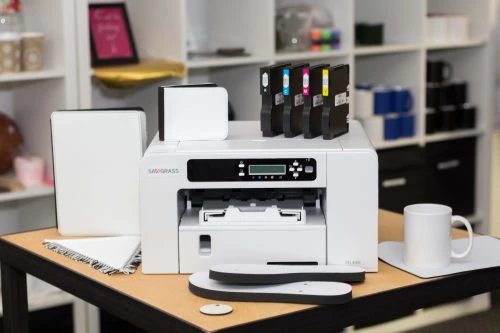A sublimation printer is a type of printer used for a specialized printing process known as dye-sublimation printing.
This process is primarily used for producing high-quality, full-color, and long-lasting prints on various materials, particularly fabrics and materials with a polymer-coated surface. Sublimation printing is commonly used for creating items such as custom apparel, promotional products, signage, and photographic prints

How Sublimation Printing Works–
Table of Contents
- Sublimation Inks: Sublimation printers use special sublimation inks, which are made up of solid dye particles that can be converted into a gas without passing through a liquid phase. These inks are typically available in cartridges specific to sublimation printing.
- Transfer Paper: To begin the printing process, a design or image is first created on a computer and then printed onto a sheet of special sublimation transfer paper using the sublimation printer. This paper is typically coated with a heat-activated polymer.
- Heat Transfer: The printed transfer paper is then placed in contact with the target material, such as a polyester fabric or a polymer-coated item (e.g., mugs, phone cases). Heat and pressure are applied to the transfer paper and the material using a heat press or a similar device.
- Sublimation Process: Under the influence of heat and pressure, the solid sublimation inks on the transfer paper turn into a gas and are absorbed into the polymer coating of the target material. The gas penetrates the polymer structure, creating a permanent bond with the material.
Advantages of Sublimation Printing–
- High-Quality Prints: Sublimation printing produces vibrant and detailed prints with a wide range of colors and tones. The resulting images are sharp and long-lasting.
- Durability: Sublimation prints are highly durable and resistant to fading, cracking, and peeling. They can withstand repeated washing and exposure to various environmental conditions.
- Full Color Range: Sublimation printing allows for the reproduction of millions of colors, making it ideal for printing photographs and complex graphics.
- No Visible Texture: Unlike some other printing methods, sublimation prints do not leave a noticeable texture on the surface of the material. The ink is embedded within the polymer coating, resulting in a smooth finish.
- Customization: Sublimation printing is well-suited for customizing a wide range of products, including clothing, home decor items, promotional merchandise, and personalized gifts.
- Environmentally Friendly: Sublimation printing is considered more environmentally friendly than some other printing processes because it generates minimal waste and doesn’t use water or solvents.
What sublimation printer prints white-

Sublimation printing, as a process, doesn’t inherently print white ink. Sublimation ink is transparent, which means it doesn’t have a white color option. Instead, sublimation printing relies on the color of the material it’s applied to, as well as the color of the material underneath it, to create the appearance of white or light-colored areas in the design. Here’s how this works
His Work-
- Material Color– In sublimation printing, the color of the material you’re printing on plays a crucial role in the final appearance of the print. If you want to have white areas in your design, you typically start with a white or light-colored material, such as a white polyester fabric or a white polymer-coated substrate (like a white ceramic mug).
- Ink Absorption: When sublimation ink is applied to the material, it becomes part of the material itself. On white or light-colored materials, the ink does not significantly alter the color because it is already close to white. This means that areas of the design that are intended to be white will take on the color of the underlying material
- Color Management: To create the appearance of white in your design, you would design your artwork with transparency in mind. For example, if you want white text on a colored background, you would simply leave those areas blank in your design file. The white material underneath will show through, creating the white text.
- Color Limitations: It’s important to note that sublimation printing has limitations when it comes to printing on dark or black materials. Since sublimation ink is transparent, it cannot effectively cover or replace dark colors. Therefore, sublimation printing is best suited for light-colored or white materials.
Conclusion– utilizing special inks and heat transfer technology, offer exceptional quality, durability, and customization capabilities. With a vast color range, smooth finish, and eco-friendly attributes, they are a versatile choice for creating vibrant and lasting prints on various materials, revolutionizing the world of custom printing
Also Read- Razer Keyboard
